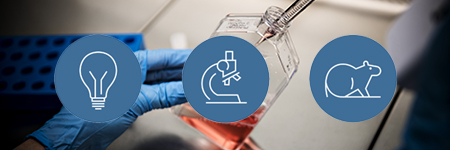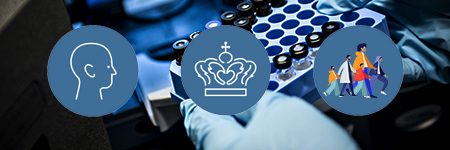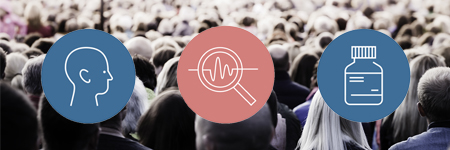The clinical trial phases
Prior to clinical trials in humans
From the idea for a new medicine to testing it in humans, it takes years of work in the lab.
The first step in medicinal development is to prove the mechanism of action in a laboratory trial, a so-called in vitro trial, which means "in glass". This phase can take several years. If the results are convincing, the next step is in vivo trials, where the medicine is tested in laboratory animals. These trials must be approved by an Animal Ethics Committee in the country concerned. They are called non-clinical trials or pre-clinical trials and are an assessment of the medicine's safety, efficacy and mechanism of action (which cells and/or processes the medicine affects in the body), as well as an assessment of the pharmacokinetics in animals. Pharmacokinetics include absorption, distribution, metabolism and excretion. This phase is both very expensive and time-consuming and can take several years. Many trials are stopped during this stage of development because the results show lack of efficacy or unacceptable side effects.
If sufficient efficacy has been demonstrated and no unacceptable side effects have been observed in the animal species the medicine has been tested in, it can move on to the next stage of development, which is testing the medicine in humans.
Clinical trials in humans
Clinical trials in humans must be approved by the authorities in the country where the trial is to be conducted, and the responsibility for obtaining this approval lies with the company or research group conducting the trial (referred to in the legislation as "the sponsor"). In Denmark, the Danish Medicines Agency, the Research Ethics Committee and the Danish Data Protection Agency must approve trials of medicines in humans.
The applicant must first obtain a license to manufacture the medicine. Authorization is granted on the basis of an inspection by the authorities to determine whether the company complies with good manufacturing procedures (GMP). Here you can find a description of the Danish Medicines Agency's control and inspection tasks.
Before the medicine is tested for the first time in humans (called a 'first in human' (FIH) study), the Danish Medicines Agency assesses the results collected from laboratory and non-clinical animal trials. The Danish Medicines Agency's doctors, toxicologists and pharmacists/biologists look at the efficacy, safety and manufacture of the medicine. If the documentation is not considered sufficient, the Danish Medicines Agency will require further studies to uncover all risks. The trial cannot be conducted until the results of the studies have been approved by the Danish Medicines Agency.
FIH studies can be conducted with healthy volunteers, but they can also be conducted in specific patient groups. Medicines with a significant potential for side effects, such as cytostatic medicine used to treat cancer, which are essentially chemotherapy, are usually studied in patients who can benefit from the medicines potential effect on their cancer.
The first phase of clinical trials (Phase I) can be an FIH, but also a trial where a well-known medicine is tested in a new disease/indication or patient group. This could, for example, be in children. Phase I trials typically involve assessing one or more of the following aspects of the investigational medicine: initial assessment of safety and tolerability, pharmacokinetics (how the body handles the medicine; absorption, distribution, metabolism and excretion), pharmacodynamics (how the medicine works in the body) and initial measurement of the medicine's effect.
In phase I, the medicine is often only tested in a small number of people (around 10 subjects). If the mechanism of action of the medicine is new and potentially very powerful, the medicine is tested on one subject at a time to reduce the risk of exposing multiple participants to any unpleasant side effects. If the results of Phase I trials are positive, you can proceed to Phase II clinical trials.
In phase II, the medicine is tested on a larger number of people with the disease the medicine is intended to treat (approximately 100 subjects).Here, the medicine is studied in patients rather than healthy individuals, as the main purpose is to investigate the therapeutic effect of the medicine. Phase II also investigates the safety of the medicine and what dose is effective.
The next phase is phase III, where the medicine is tested in a large group of patients under more everyday conditions to confirm the effect of the medicine. In this large group, a more detailed picture of the effect and possible side effects of the medication is obtained. A Phase III study typically lasts several years and includes up to several thousand individuals.
Phase IV begins after the medicine has been approved for marketing. Studies on the therapeutic use of a medicine go beyond the earlier demonstration of the medicine's safety, efficacy and dose determination. These trials often play an important role in optimizing the use of the medication and detecting possible side effects that may occur, for example, in patients who are being treated with multiple medications.
Read more here: ICH E8 General considerations for clinical studies - Scientific guideline | European Medicines Agency (europa.eu)



